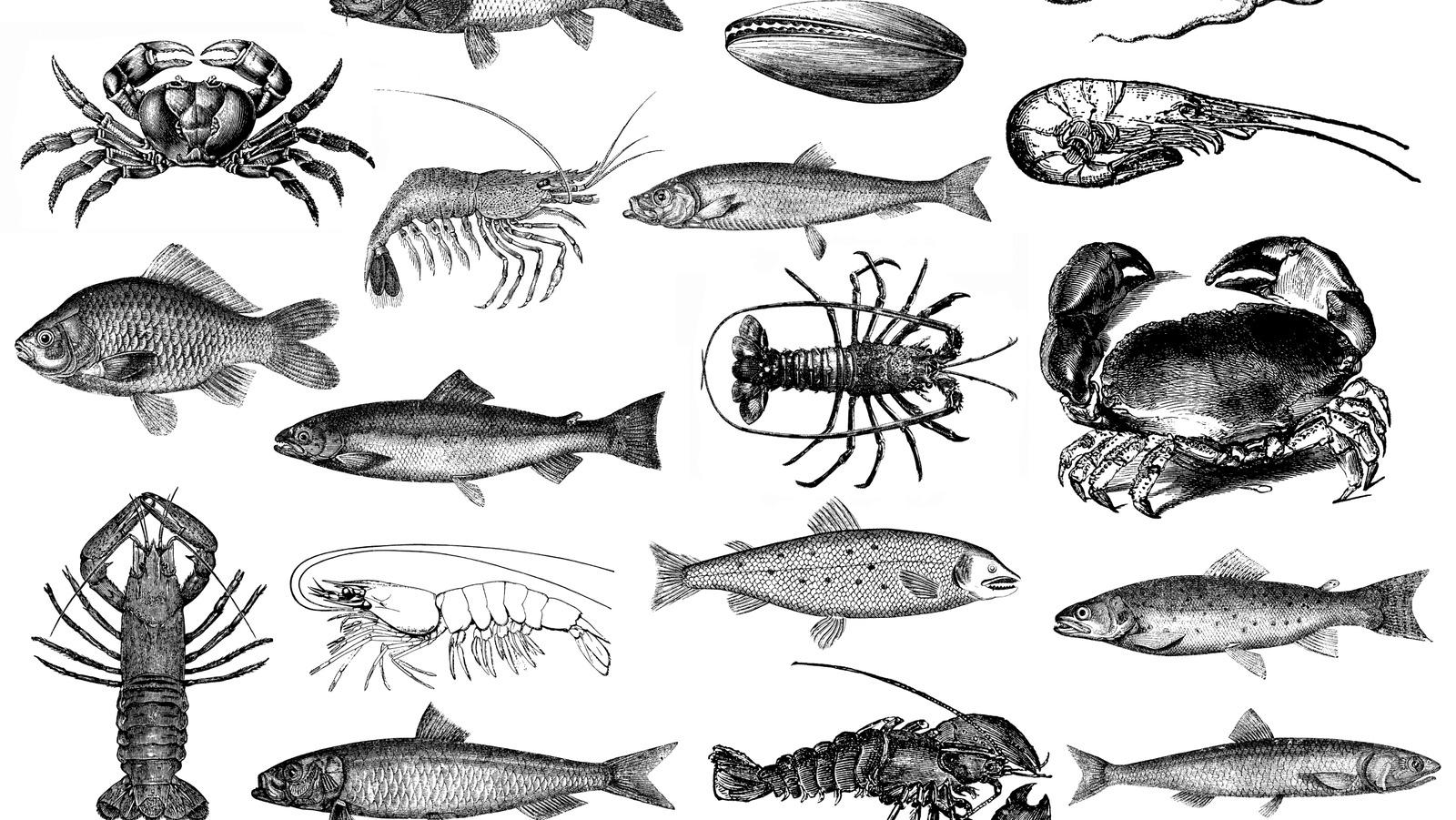
Nsa Digital Archive/Getty Images
Seafood dishes have evolved a lot. From fine dining's fascination with crudo and the raw bar to a renewed focus on locally sourced fish, 21st century seafood is all about sustainably caught fish prepared in simple yet refined ways. Old-school seafood recipes carry a general reputation for being fussy, unexciting, or containing an odd combination of ingredients. This isn't true of all retro seafood dishes though. Some of them were really good, but they went out of style anyway.
Back in the day, most formal seafood dishes had a distinct French influence. If a restaurant was billed as fine dining, French haute cuisine was the expectation for both the chefs and the diners. Baked fish with breadcrumbs and white wine was a dominant practice in these spaces, but there were some pops of ingenuity happening every now and then. Meanwhile, ambitious mid-century home cooks with an arsenal of recipe cards were keeping busy. We often think of recipes in this genre as outdated and unusual, but more than a few of them are worth trying — seafood dishes included.
Lots of old-school seafood dishes are still eaten today because they've always been relevant to some degree. Classics like fried catfish and shrimp cocktail are not what you'd call obscure. This list is for the seafood dishes that faded into the back pages of time, and they deserve to make a comeback.
Shad roe
We'll be the first to admit that shad roe is not the most attractive seafood dish out there, but it's a delicacy in its own right — to those who remember eating it. Shad are the largest member of the herring family, but it's not the meat of the fish that gets all the attention, it's the egg sacs of the female shad, filled with hundreds of thousands of tiny roe. Shad are anadromous fish of the Atlantic coast, meaning they primarily live in salt water but migrate to freshwater every year to lay their eggs.
In early spring, Shad swim to freshwater, marking the start of the narrow shad row fishing season. The dual egg sacs of the female shad, are removed and kept intact during cooking and serving. The sacs are soft and veiny, which is understandably unappetizing for some. If you can get past that, shad roe is a rich yet delicate seafood. Classic recipes call for a sauce of lemon butter. Bacon-wrapped shad roe was another favorite back in the day.
Shad roe was a big deal back in the 19th and 20th centuries, some even likened it to the foie gras of the sea ... without the force feeding and slaughtering ritual. In 1871, shad were transplanted into the Sacramento River so that West coasters could enjoy shad's bounty like they did in the east. Over time, water pollution and overfishing made shad harder to come by, and people ate it less and less.
Lobster thermidor
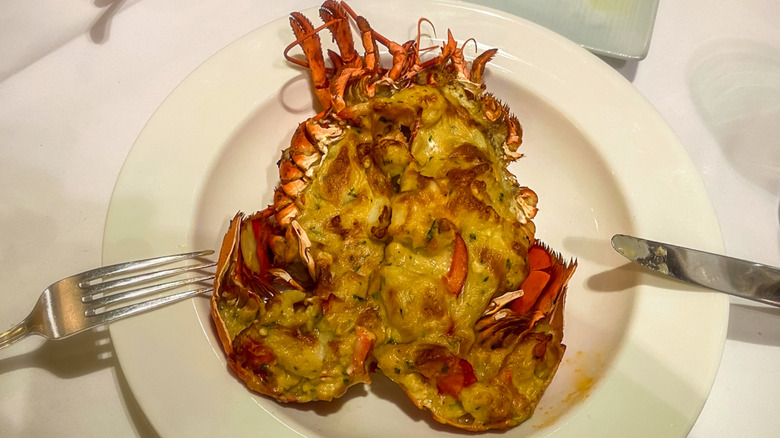
Neslihan Gorucu/Getty Images
If you immediately associate Lobster Thermidor with "The Lego Batman Movie," from 2017, you're not alone. Before the film's title character fixated on the finer points of Lobster Thermidor preparation, the dish mainly existed to feed people at formal dinners or events. The dish consists of a split lobster that is grilled, returned to its shell, coated in a creamy velouté sauce, then lightly broiled. It was the peak of refinement upon its inception in Paris in the 1890s and was a hit throughout America too ... up to a point. Slowly but surely, Lobster Thermidor was dismissed as an old-fashioned dish that was kind of snooty and overrated.
Should we be more like Lego Batman and give Lobster Thermidor another chance? By nature, Lobster Thermidor will always be a sophisticated dish, but it doesn't necessarily have to be outdated. Even classic Lobster Thermidor recipes have a good amount of variation, which leaves room for reinterpretation with ingredients that are well-suited to the modern palate.
The Lobster Thermidor recipe by legendary French chef Auguste Escoffier — who is sometimes credited for creating the dish — calls for a flambéed brandy-infused cream sauce with egg yolks, a dash of English mustard, and a sprinkle of parsley. Julia Child's 20th-century Lobster Thermidor incorporates white wine, onions, celery, carrot, and a mixture of herbs — all departures from Escoffier's version. At the Cape Cod Room restaurant at Chicago's Drake Hotel, Lobster Thermidor is livened up by adding mushrooms and cayenne to the sauce.
Salmon patties

Merrimon Crawford/Shutterstock
It's a beautiful thing when seafood and comfort food join forces, and in many ways salmon patties are a shining example of that combination. They're warm, savory, and a little fluffy, almost like a potato latke but with fish as the star ingredient. Salmon patties have been around for a long time, yet we don't come across them too often these days.
Salmon, egg, breadcrumbs , and some seasonings are the only ingredients you need to whip up this old-school seafood dish, which has always exuded a rustic charm. It's also a versatile, no-frills recipe that can come to fruition with either fresh or canned salmon — some recipes even state that removing the fish's skin and bones isn't necessary. Salmon patties served in the Southern traditional style are eaten with sides such as coleslaw, corn, or mashed potatoes.
Salmon patties aren't exclusively an old-time Southern dish. Culinary influences stretching from Newfoundland to Denmark informed the retro popularity of salmon patties — but that wasn't all. The Great Depression had an unignorable effect on the way people ate day-to-day. Salmon Patties made from canned salmon, flour, breadcrumbs, or crushed crackers were touted as an affordable and nourishing meal of the difficult Depression era. It's also one of the recipes from that time that could still fit in with the culinary tastes of the modern age.
Crab pie
Why did people give up on crab pie? It's a classic, homestyle dish, with Southern sensibilities and an enticing crab flavor. Crab pie shouldn't linger in the peripheries of public consciousness any longer, in fact, we're curious how crab pie became semi-forgotten in the first place.
As time rolls on, creamy or dairy elements and fish have been kept apart. This motivation is based on the culinary principle that these two food groups don't go together — but it's not always true. Crab pie's origins are not set in stone, but they have been linked to Martha Washington, America's original first lady. Blue crab was a local delicacy near the Washington's home in Virginia and said to be a favorite of Martha's. Savory pies were big in the colonial era, so a crab pie would have fit right into what was trending food-wise back then.
Crab pie isn't an enduring old-fashioned recipe like shepherd's pie or chicken pot pie are, and that could use some amending. Crab meat brings a lot of flavor to seafood dishes and is a versatile ingredient of coastal cuisine. It brings the same value to a savory meat-based pie as well.
Trout Amandine
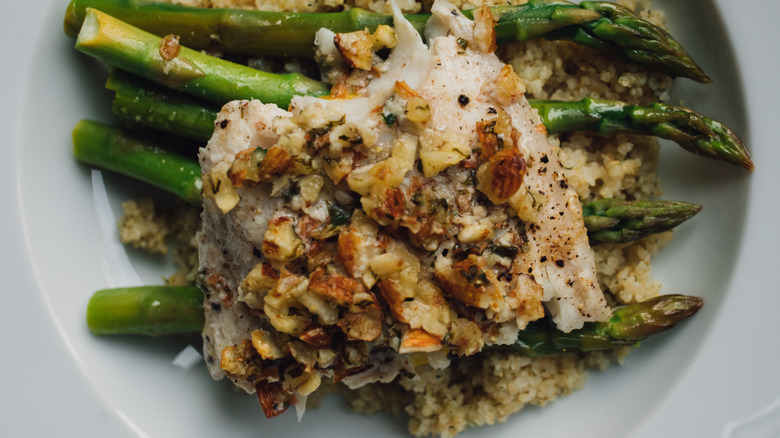
Nicole Kandi/Shutterstock
Whether you call it trout amandine or trout almondine, this distinguished seafood dish with roots in Western European cuisine deserves a second chance in the spotlight. "Almondine" or "amandine" refers to the French term for preparing food with almonds. Traditionally, it was dover sole that was topped with toasted almonds, but when the dish became popular in Louisiana (by way of Creole cuisine), dover sole was replaced with speckled trout, which was cheaper and easier to find. Trout Amandine is a classic, but its popularity peaked in the 1960s.
Encrusting food in sliced almonds may come across as old-school, but there's more to trout amandine than rolling a piece of fish in nuts. Trout amandine calls for a pan sauce of brown butter and lemon and spooning it over the trout that has been seasoned, dredged in flour, and sautéed in a skillet. This classic preparation is known in French cooking as "meunière," and it's an especially effective flavor pairing with white fish because it enhances the fish's subtle flavor without overpowering it. Julia Child was a huge fan of the meunière technique.
The textural contrast of crisp almonds cooked in brown butter and the soft, flaky fish make trout amandine a seafood dish that needs a little more love than it's gotten in recent years. Modern recipes often use rainbow trout, as opposed to the saltwater-dwelling speckled trout that was embraced in Southern kitchens so many years ago.
Coquilles St Jacques
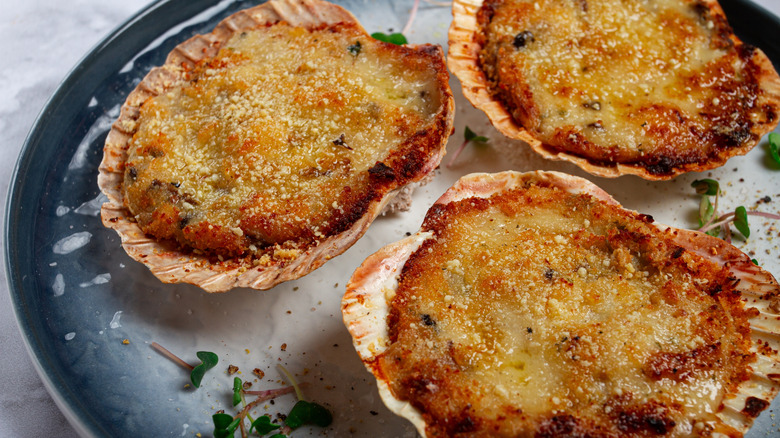
Didebashvili.GEO/Shutterstock
Back in the day, Americans really enjoyed eating coquilles St Jacques (ko-kee san zhak), even if they had trouble pronouncing it. "Coquille St Jacques" is the French word for "scallop", but as an entrée, it takes on a more nuanced meaning. Traditional coquilles St Jacques involves sautéing scallops in white wine, butter, and shallots, returning them to their half shell, sprinkling them with cheese and baking. Elegant? Oui. Yet people lost interest in coquilles St Jacques.
Mid-20th century French restaurants in New York City and elsewhere typically served coquilles St Jacques as a first course or appetizer. Recipes varied — some included mushroom purée inside the scallop shell, with the scallops placed on top. Others leaned more into sautéed onions and herbs. What all authentic coquilles St Jacques recipes have in common is a sauce of white wine, butter, and shallots, finished with a gratinéed crust of cheese. As time went on, seared scallops with greens and vinaigrettes became more common in restaurants than gratinéed anything, let alone shellfish.
Maybe the recipe was a little too precious, or buttery, or too fish-with-cheesy for people's evolving tastes. What we know for sure is that French gastronomy had a profound influence on fine dining for so long — a lot of old-school seafood dishes have a distinct Francophile flair. Coquilles St Jacques is worthy of revisiting, but it's also nice to have a more multicultural point of view in the seafood dishes of today.
Lobster Newburg
Cream-based sauces and fish aren't the popular pairing they once were, but sometimes the combo can make for a tasty dish. Take Lobster Newburg for instance. Lobster Newburg came about in the late 1800s, and like many respectable seafood dishes, it was the brainchild of someone who was well-acquainted with the sea. Captain Ben Wenburg conceptualized the dish, featuring hunks of poached lobster meat enveloped in a creamy cognac sauce. Wenburg passed the recipe onto Charles Delmonico, owner of legendary New York City steakhouse and premier fine dining establishment, Delmonico's.
The restaurateur was charmed by the captain's culinary innovation and put it on Delmonico's menu under the name, "Lobster a la Wenburg." Delmonico's catered to some seriously high-profile clientele (think Abe Lincoln and Mark Twain), and the general consensus among diners was that Lobster a la Wenburg ruled. After Delmonico and Wenburg got in a fight, Delmonico got petty and took Lobster a la Wenburg off the menu. He eventually brought it back due to popular demand, but renamed the dish Lobster Newburg.
Although Captain Wenburg's name was disassociated with the dish, there's no changing the fact that he brought something creative and classy to the table all those years ago. Lobster Newburg was adopted by restaurants all over the U.S., and variations like Seafood Newburg or serving the dish with warm bread were also common. As time passed and more restaurants riffed on Lobster Newburg, the dish lost some of its original finesse and fell out of style.
Fish Puttanesca
Puttanesca roughly translates to "harlot's sauce," leading some to believe it was created by Italian sex workers who wanted to lure in clients. It's an amusing tale, but not an accurate one. Puttanesca, the spicy pasta sauce of tomatoes, olives, capers, and cured anchovy, has more likely origins in 1950s Ischia, just off the coast of Naples. Sandro Petti, an Ischian restaurant owner, invented the sauce on a whim when he agreed to cook for a group but had limited ingredients on-hand. They told Petti to use "puttanata qualsiasi" or, "whatever rubbish" he could find. While puttanesca sauce remains popular, fish puttanesca gets less attention.
Instead of stirring in tinned anchovies, fish puttanesca brings a larger fish into the chunky tomato sauce. Pieces of tuna, swordfish, or white fish like halibut give brininess to the sauce and add a firm yet flaky textural element. These fish aren't salty like cured anchovies are, but fish puttanesca retains its signature saltiness by way of olives and capers. Fish puttanesca is a highly customizable seafood dish. Broken up pieces of fish or an intact filet can be used. Some recipes serve the fish and sauce over a bed of spaghetti, others don't integrate pasta at all.
If you see fish puttanesca these days, it's usually being prepared by a home cook. Restaurants tend to favor the version with anchovies over the sauce with larger fish. Anchovy in puttanesca is fantastic, but old-school fish puttanesca is also worth a try.
Crab Louie
When the word "salad" is in the title of old recipes, there's a fair chance that the salad will contain gelatin or food coloring (or perhaps both). Crab Louie isn't like that. First of all, the star ingredient of Crab Louie is dungeness crab, an absolute gem of the Northwest Pacific waters — so how could that be bad? Also, it's a traditional type of cold salad with a bed of iceberg lettuce as its base. Other supporting ingredients include sliced hard boiled egg and fresh tomatoes.
Just as we've seen with lots of old-school dishes, Crab Louie's origins are a bit murky and disputed. Its origins are credited to West Coast cities in the early 1900s — primarily San Francisco and Seattle. The salad was a favorite of mid-century era visitors and soon enough, home cooks were adopting it as well. On the East coast where dungeness crab is not readily available, variations on the dish — like trading the crab meat for shrimp — became common. The salad's dressing was similar to the basic recipe for thousand island dressing.
Why did a yummy salad like Crab Louie fall out of favor? It's hard to say. It's possible that less special salads congested the space on restaurant menus. Our suggestion: if you come across Crab Louie, don't hesitate to take a bite.
Baked oysters
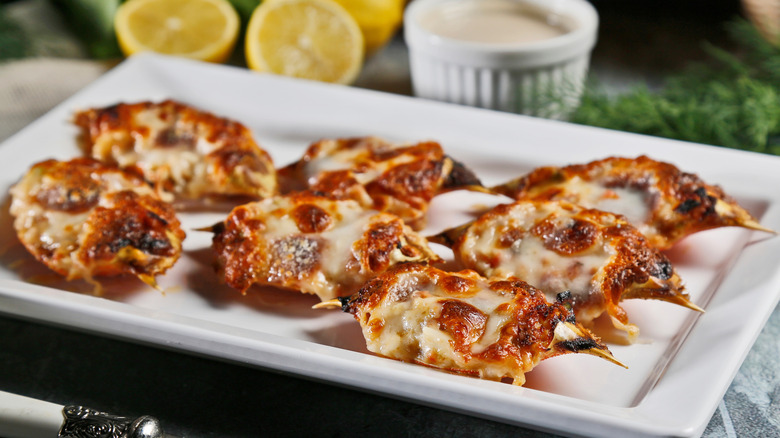
Hashem Issam Alshanableh/Shutterstock
Raw oysters have become so popular — especially at restaurants — that baked oyster dishes of eras past have been more or less left in the dark. Baked oysters really took off in New Orleans. Oysters Rockefeller, a dish that dates back to the late 19th century, debuted at Antoine's, a landmark New Orleans restaurant. Oysters Bienville, a baked oyster dish of peppers, onions, cream, mushrooms, shrimp, grated cheese, and breadcrumbs is another throwback dish that got its start in New Orleans. Antoine's claims to have invented both Oysters Rockefeller and Oysters Bienville, yet the latter was known as the signature dish at Arnaud's, another Crescent City institution.
Oysters Rockefeller was a standard-setting baked oyster dish. It's a rich first course, featuring a luxuriant green sauce and toasted breadcrumbs that inspired Antoine's son Jules Alciatore to name it after the legendary American tycoon. The original recipe was so top secret and could never be duplicated to the letter. Oysters Bienville were also unapologetically posh. Distinctive, French-inspired flavors like white wine and mushroom, bolster its flavor profile, while the inclusion of peppers add a zesty angle.
Nowadays, when people get excited about oysters, it's almost always the ones from the raw bar. Baked oysters like the ones from New Orleans are fantastic, however, layering the simple deliciousness of the bivalve with a lot of extra ingredients and flavors. Oyster-loving purists may not be interested in the baked versions from back in the day, but that doesn't mean they aren't tasty.
Creamed Finnan Haddie
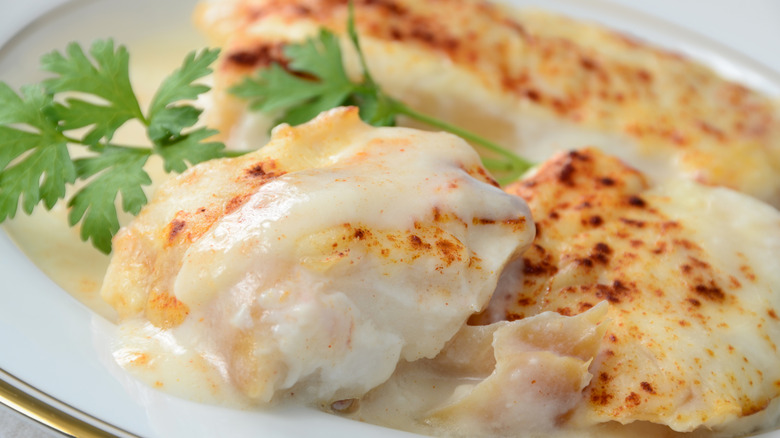
Sbossert/Getty Images
Finnan haddie, the cute Scottish name for smoked haddock, is a New England seafood dish that came to American tables by way of the British Isles. Smoking haddock was a process fisherman in Northeastern Scotland perfected in the 18th and 19th centuries. "Finnan" haddie refers to the small fishing village where the smoking technique was developed. Poaching smoked haddock in milk enhanced its depth of flavor and spawned seafood dishes that paired dairy with smoked haddock, including creamed finnan haddie, an old-fashioned dish that was a popular breakfast and lunch food that's in need of some reviving.
To make creamed finnan haddie, pieces of smoked haddock are simmered in a mix of cream, milk, onion, and a bay leaf and served over toast or another New England classic, johnnycakes. Some recipes call for butter and flour to thicken the cream sauce as well as salt, black pepper and a pinch of nutmeg to season it. The pieces of haddock may also vary in size, from forkful-sized chunks to flaked bits mixed in the cream sauce.
For many, creamed finnan haddie is a memorable dish that was passed down from the elder generations. At the same time, a lot of people have recollections of trying creamed finnan haddie and disliking it. The smell and a gloopy consistency are some of the reasons people are turned off by this old-school seafood concoction, but if you've never had well-executed creamed finned haddie on toast, it might be worth a try.



